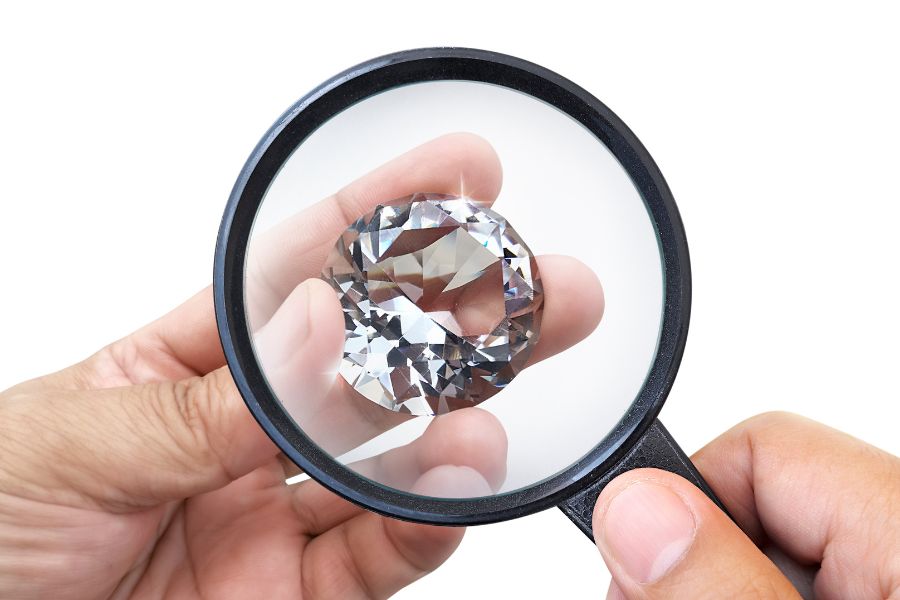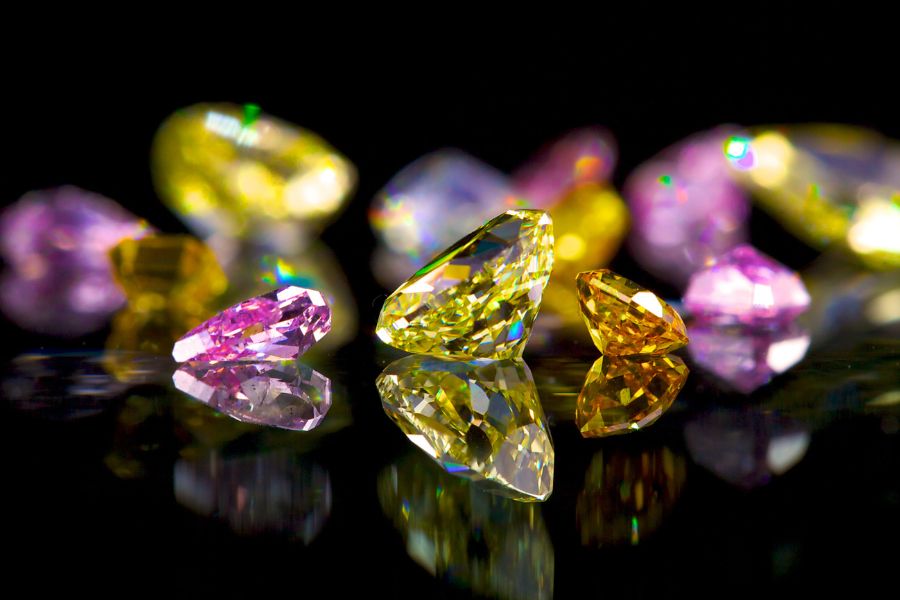Curious about what is a composite diamond and how it fits into the world of fine jewelry? Whether you're exploring options for an engagement ring or simply interested in unique gemstones, understanding the different types of diamonds available can help you make an informed decision.
In this article, we'll delve into what makes composite diamonds special, compare them to real diamonds, and offer guidance on choosing and caring for them to ensure you find the perfect piece.

A composite diamond is a piece of jewelry made from two or more smaller diamonds that are carefully set together to create the illusion of a single, larger diamond. The composite diamond meaning refers to how jewelers arrange these smaller stones in a pattern that maximizes sparkle and makes the cluster appear as one unified gem. The goal is to mimic the look of a larger, more expensive diamond at a fraction of the cost.
Composite diamonds are often used in rings, earrings, and other types of jewelry. They offer a budget-friendly alternative to buying a single, large diamond. While they can look impressive, it's essential to know their specific characteristics before making a purchase.

Now that you know what is a diamond composite, let's explore the pros and cons. Understanding these will help you decide if a composite diamond is the right choice for you.
1. Affordability and Value: Composite diamonds offer excellent value for those on a budget. They provide the look of a larger, stunning ring without the high cost of a single large diamond.
2. Design Variety: With composite diamonds, you can explore unique designs and shapes that single-stone rings don't offer, like flowers, ovals, halos, or clusters that create a vintage charm.
3. Versatility in Stones: Composite rings can incorporate different stones and gemstones, imitating the appearance of a larger diamond and offering more creativity in design.
4. Everyday Wear: Composite diamond rings can complement an existing solitaire diamond or wedding band, making them perfect for everyday wear with a matching solitaire color.
5. Brilliance: When skillfully arranged, composite diamonds can provide a dazzling, brilliant appearance that mimics the sparkle of a larger stone.
6. Artistic Expression: These rings allow for more artistic design and versatility. They can mimic a traditional solitaire diamond from a distance or embrace a more casual, trendy look up close.
1. Durability: Composite diamonds may be less durable than a single stone. The smaller diamonds and the setting holding them together can be more fragile, leading to potential damage.
2. Complexity of Repair: Composite diamonds often consist of multiple stones in various sizes. If a stone comes loose or is damaged, repairs can be more intricate and costly compared to a single-stone diamond.
3. Limited Future Value: Composite diamonds typically have lower resale value due to their construction. Since they consist of multiple small diamonds rather than one large stone, their future value is generally more limited.
4. Inconsistent Sparkle: The sparkle may vary depending on how well the smaller diamonds are arranged, and it may not have the uniform brilliance of a single larger diamond.
When comparing composite diamonds to real diamonds, it's important to consider a few key factors: appearance, value, and durability.
Composite diamonds are made from multiple small stones, including natural diamonds, lab-grown diamonds, moissanite, or cubic zirconia, while real diamonds are single, solid stones.
At first glance, a well-made composite diamond can look just like a real diamond. The cluster of small stones is designed to create the sparkle and brilliance of a single, larger diamond. However, upon closer inspection, an expert can usually tell the difference. The lines between the individual stones may be visible, especially if the diamonds are not perfectly matched in color and clarity.
Composite diamonds are more affordable than real diamonds, making them a popular choice for those looking to save money. However, their overall value is lower since they consist of smaller stones. A real diamond might be a more suitable option if you're seeking a diamond with long-term investment potential.
Real diamonds are known for their incredible hardness and durability. They are one of the hardest natural substances on earth, making them resistant to scratches and damage. Composite diamonds, on the other hand, can be more delicate. The small stones can be more susceptible to damage, and the setting may not be as sturdy as that of a single diamond.

If you've decided that a composite diamond is right for you, here are some tips on how to choose the best one.
Look for composite diamonds made from high-quality stones. The smaller diamonds should be well-cut and have good clarity and color. Even though they are small, these factors will affect the piece's overall appearance.
The setting is crucial in composite diamonds. Make sure the stones are securely set and that the setting is well-made. A strong, durable setting will help prevent the stones from coming loose over time.
Composite diamonds come in various designs, from traditional to modern. Choose a design that matches your style and complements your wardrobe. Whether you prefer a classic round cluster or a more unique shape, there is likely a composite diamond that will suit your taste.
One of the main benefits of composite diamonds is that they can create the illusion of a larger stone. Consider how large you want the overall piece to appear and choose a composite diamond that achieves that look.
Because composite diamonds can be more prone to damage, it's a good idea to ask about the warranty. Ensure the jeweler offers a warranty that covers repairs if any stones come loose or the setting is damaged.
Caring for a composite diamond requires a bit more attention than caring for a single diamond. Here are some tips to keep your composite diamond looking its best.
Composite diamonds often collect dirt and debris in the tiny gaps between the stones. To keep them sparkling, it's important to clean them regularly. Use a soft brush and mild soap for a gentle clean. Steer clear of strong chemicals that could harm the setting or the individual stones.
Composite diamonds are more delicate than single diamonds, so avoiding any hard impacts is essential. Remove your jewelry when doing activities that could cause damage, such as sports or heavy lifting.
Regularly inspect the setting to ensure the stones are secure. If you notice any stones that seem loose or if the setting appears damaged, take your jewelry to a jeweler for repair.
Store your composite diamond in a soft pouch or lined jewelry box when not wearing it. This will help prevent scratches and damage to the stones and setting.
Understanding what is a composite diamond can help you make an informed decision when shopping for jewelry. Composite diamonds offer an affordable and visually appealing alternative to single diamonds. They provide flexibility in design and can create the illusion of a larger, more expensive stone. However, they may require more maintenance and do not hold the same value as real diamonds. By carefully choosing and caring for your composite diamond, you can enjoy its beauty for years to come.
Composite diamonds can be of good quality, especially if the small diamonds used are clear and well-cut. The overall appearance can be impressive, but the quality depends on the individual stones and the craftsmanship of the setting. Regular maintenance is key to preserving their look.
"1 CT TW" stands for "1 carat total weight." This means the combined weight of all the small diamonds in the composite adds up to 1 carat. It doesn't refer to a single diamond but the total weight of the smaller diamonds used in the setting.
Composite diamonds are made from real gemstones, such as natural or lab-grown diamonds. However, they are clusters of smaller stones, not a single large diamond, which makes them less valuable. Some may also include alternatives like moissanite or cubic zirconia.
Discover how to reset diamond ring: transform its look, save on costs, and make it shine like new. Explore reasons, tips, and expenses for a stunning upgrade.
Read MoreDiscover 10 types of stone settings with our comprehensive guide. Learn about various techniques to enhance your jewelry and make every gem shine.
Read MoreMaster how to make a spoon ring with our intuitive guide. Effortlessly turn vintage flatware into decorative pieces to elevate your style and make a statement.
Read MoreWondering why does my nose ring smell? Discover the common culprits and Learn expert tips on how to effectively clean and maintain your nose ring in style.
Read More